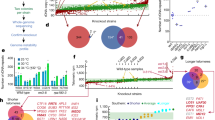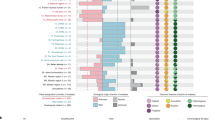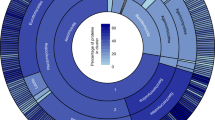Abstract
Although most eukaryotic genomes lack operons, they contain some physical clusters of genes that are related in function despite being unrelated in sequence1,2,3,4,5. How these clusters are formed during evolution is unknown. The DAL cluster is the largest metabolic gene cluster in yeast and consists of six adjacent genes encoding proteins that enable Saccharomyces cerevisiae to use allantoin as a nitrogen source6. We show here that the DAL cluster was assembled, quite recently in evolutionary terms, through a set of genomic rearrangements that happened almost simultaneously. Six of the eight genes involved in allantoin degradation, which were previously scattered around the genome, became relocated to a single subtelomeric site in an ancestor of S. cerevisiae and Saccharomyces castellii. These genomic rearrangements coincided with a biochemical reorganization of the purine degradation pathway, which switched to importing allantoin instead of urate. This change eliminated urate oxidase, one of several oxygen-consuming enzymes that were lost by yeasts that can grow vigorously in anaerobic conditions. The DAL cluster is located in a domain of modified chromatin involving both H2A.Z histone exchange and Hst1-Sum1–mediated histone deacetylation, and it may be a coadapted gene complex formed by epistatic selection.
This is a preview of subscription content, access via your institution
Access options
Subscribe to this journal
Receive 12 print issues and online access
$209.00 per year
only $17.42 per issue
Buy this article
- Purchase on Springer Link
- Instant access to full article PDF
Prices may be subject to local taxes which are calculated during checkout



Similar content being viewed by others
References
Hurst, L.D., Pal, C. & Lercher, M.J. The evolutionary dynamics of eukaryotic gene order. Nat. Rev. Genet. 5, 299–310 (2004).
Qi, X. et al. A gene cluster for secondary metabolism in oat: implications for the evolution of metabolic diversity in plants. Proc. Natl. Acad. Sci. USA 101, 8233–8238 (2004).
Lee, J.M. & Sonnhammer, E.L. Genomic gene clustering analysis of pathways in eukaryotes. Genome Res. 13, 875–882 (2003).
Keller, N.P. & Hohn, T.M. Metabolic pathway gene clusters in filamentous fungi. Fungal Genet. Biol. 21, 17–29 (1997).
Blumenthal, T. & Gleason, K.S. Caenorhabditis elegans operons: form and function. Nat. Rev. Genet. 4, 112–120 (2003).
Cooper, T.G. Regulation of allantoin catabolism in Saccharomyces cerevisiae . in The Mycota III: Biochemistry and Molecular Biology (ed. Marzluf, G.A.) 139–169 (Springer, Berlin, 1996).
Pal, C. & Hurst, L.D. Evidence for co-evolution of gene order and recombination rate. Nat. Genet. 33, 392–395 (2003).
Cohen, B.A., Mitra, R.D., Hughes, J.D. & Church, G.M. A computational analysis of whole-genome expression data reveals chromosomal domains of gene expression. Nat. Genet. 26, 183–186 (2000).
Hurst, L.D., Williams, E.J. & Pal, C. Natural selection promotes the conservation of linkage of co-expressed genes. Trends Genet. 18, 604–606 (2002).
Hittinger, C.T., Rokas, A. & Carroll, S.B. Parallel inactivation of multiple GAL pathway genes and ecological diversification in yeasts. Proc. Natl. Acad. Sci. USA 101, 14144–14149 (2004).
Kellis, M., Birren, B.W. & Lander, E.S. Proof and evolutionary analysis of ancient genome duplication in the yeast Saccharomyces cerevisiae . Nature 428, 617–624 (2004).
Kurtzman, C.P. & Robnett, C.J. Phylogenetic relationships among yeasts of the 'Saccharomyces complex' determined from multigene sequence analyses. FEMS Yeast Res. 3, 417–432 (2003).
Hartig, A. et al. Differentially regulated malate synthase genes participate in carbon and nitrogen metabolism of S. cerevisiae . Nucleic Acids Res. 20, 5677–5686 (1992).
LaRue, T.A. & Spencer, J.F. The utilization of purines and pyrimidines by yeasts. Can. J. Microbiol. 14, 79–86 (1968).
van der Klei, I.J. & Veenhuis, M. Yeast peroxisomes: function and biogenesis of a versatile cell organelle. Trends Microbiol. 5, 502–509 (1997).
Piskur, J. & Langkjaer, R.B. Yeast genome sequencing: the power of comparative genomics. Mol. Microbiol. 53, 381–389 (2004).
Deak, T. & Beuchat, L.R. Handbook of Food Spoilage Yeasts (CRC Press, Boca Raton, Florida, USA, 1996).
Kwast, K.E. et al. Genomic analyses of anaerobically induced genes in Saccharomyces cerevisiae: functional roles of Rox1 and other factors in mediating the anoxic response. J. Bacteriol. 184, 250–265 (2002).
Peoples, M.B. & Gifford, R.M. Regulation of the transport of nitrogen and carbon in higher plants. in Plant Metabolism (eds. Dennis, D.T., Layzell, D.B., Lefebvre, D.D. & Turpin, D.H.) 525–538 (Longman, Singapore, 1997).
Bursell, E. The excretion of nitrogen in insects. Adv. Insect Physiol. 4, 33–67 (1967).
Nei, M. Modification of linkage intensity by natural selection. Genetics 57, 625–641 (1967).
Robyr, D. et al. Microarray deacetylation maps determine genome-wide functions for yeast histone deacetylases. Cell 109, 437–446 (2002).
Meneghini, M.D., Wu, M. & Madhani, H.D. Conserved histone variant H2A.Z protects euchromatin from the ectopic spread of silent heterochromatin. Cell 112, 725–736 (2003).
Krogan, N.J. et al. A Snf2 family ATPase complex required for recruitment of the histone H2A variant Htz1. Mol. Cell 12, 1565–1576 (2003).
Robert, F. et al. Global position and recruitment of HATs and HDACs in the yeast genome. Mol. Cell 16, 199–209 (2004).
Pierce, M. et al. Sum1 and Ndt80 proteins compete for binding to middle sporulation element sequences that control meiotic gene expression. Mol. Cell. Biol. 23, 4814–4825 (2003).
Kellis, M., Patterson, N., Endrizzi, M., Birren, B. & Lander, E.S. Sequencing and comparison of yeast species to identify genes and regulatory elements. Nature 423, 241–254 (2003).
Daran-Lapujade, P. et al. Comparative genotyping of the Saccharomyces cerevisiae laboratory strains S288C and CEN.PK113–7D using oligonucleotide microarrays. FEMS Yeast Res. 4, 259–269 (2003).
Gerton, J.L. et al. Global mapping of meiotic recombination hotspots and coldspots in the yeast Saccharomyces cerevisiae . Proc. Natl. Acad. Sci. USA 97, 11383–11390 (2000).
Takada, Y. & Tsukiji, N. Peroxisomal localization and activation by bivalent metal ions of ureidoglycolate lyase, the enzyme involved in urate degradation in Candida tropicalis . J. Bacteriol. 169, 2284–2286 (1987).
Acknowledgements
We thank D. Scannell, K. Byrne, J. Gordon, G. Conant, N. Khaldi, B. Cusack, L. Rusche, J. Conery and anonymous referees for comments. This study was supported by Science Foundation Ireland.
Author information
Authors and Affiliations
Corresponding author
Ethics declarations
Competing interests
The authors declare no competing financial interests.
Supplementary information
Supplementary Fig. 1
Organization of the DAL clusters of S. cerevisiae aned S. castellii. (PDF 84 kb)
Supplementary Fig. 2
Locations of DALgenes (red) in species lacking the DAL cluster. (PDF 421 kb)
Supplementary Fig. 3
Phylogenetic trees of Dal4/Fur4 and Dal7/Mls1 sequences. (PDF 40 kb)
Supplementary Fig. 4
The DAL cluster is a meiotic recombination coldspot. (PDF 30 kb)
Supplementary Table 1
Sequence evolution in DAL genes. (PDF 68 kb)
Rights and permissions
About this article
Cite this article
Wong, S., Wolfe, K. Birth of a metabolic gene cluster in yeast by adaptive gene relocation. Nat Genet 37, 777–782 (2005). https://doi.org/10.1038/ng1584
Received:
Accepted:
Published:
Issue Date:
DOI: https://doi.org/10.1038/ng1584
This article is cited by
-
Ten decadal advances in fungal biology leading towards human well-being
Fungal Diversity (2022)
-
Three chromosome-scale Papaver genomes reveal punctuated patchwork evolution of the morphinan and noscapine biosynthesis pathway
Nature Communications (2021)
-
Analysis of the chromosomal clustering of Fusarium-responsive wheat genes uncovers new players in the defence against head blight disease
Scientific Reports (2021)
-
Chromosome rearrangements shape the diversification of secondary metabolism in the cyclosporin producing fungus Tolypocladium inflatum
BMC Genomics (2019)
-
Evolutionary and functional patterns of shared gene neighbourhood in fungi
Nature Microbiology (2019)



